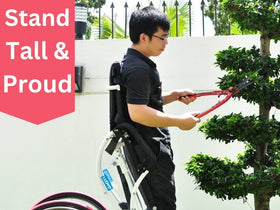
A Comprehensive Guide to Replacing Bike Headlights and Taillights
Cycling is not only an eco-friendly mode of transportation but also an excellent way to stay active and enjoy the outdoors. However, for your safety, it's crucial to ensure that your bike is equipped with functioning headlights and taillights. These lights help you see the road ahead and make you visible to others, especially in low-light conditions or during nighttime rides.
In this comprehensive guide, we'll walk you through the step-by-step process of replacing both the headlight and taillight on your bike.

Before You Begin
Before diving into the replacement process, you'll need a few tools and materials:
-
Replacement Headlight and Taillight: Ensure you have the correct type of lights for your bike. LED lights are a popular choice for their brightness and energy efficiency.
-
Screwdriver: A Phillips or flat-head screwdriver, depending on your bike's design.
-
Batteries: Check the requirements for your lights and have the appropriate batteries on hand.
-
Rubber Gloves: Optional but useful to keep your hands clean and prevent any damage to the bulbs.
-
Workspace: Find a well-lit area to work on your bike, preferably with a flat surface.
Replacing the Headlight
Step 1: Turn Off the Old Headlight
If your bike's headlight is still operational, turn it off. You don't want to accidentally blind yourself while working on it.
Step 2: Locate and Remove the Old Headlight
-
Most bike headlights are attached to the handlebars. Locate the headlight housing and find the screws or clamps holding it in place.
-
Use your screwdriver to loosen and remove these screws or clamps. Be careful not to lose any small parts.
-
Gently pull the old headlight away from the mounting bracket.
Step 3: Replace the Batteries
If your headlight is battery-powered, open the battery compartment, and replace the old batteries with new ones. Make sure to follow the correct polarity (positive and negative) when inserting the batteries.
Step 4: Attach the New Headlight
-
Align the new headlight with the mounting bracket on your handlebars.
-
Secure it in place using the screws or clamps you removed earlier. Make sure it's firmly attached and doesn't wobble.
Step 5: Test the New Headlight
Turn on the new headlight to ensure it's functioning correctly. Adjust the beam angle if necessary to optimize visibility without blinding oncoming traffic.

Replacing the Taillight
Step 1: Turn Off the Old Taillight
If your bike's taillight is still operational, turn it off to avoid unnecessary battery drain.
Step 2: Locate and Remove the Old Taillight
-
Most taillights are attached to the bike's seat post or rear frame. Find the screws or clamps securing the taillight.
-
Use your screwdriver to remove these screws or clamps, just like with the headlight.
-
Carefully detach the old taillight from its mounting bracket.
Step 3: Replace the Batteries
If your taillight uses batteries, open the battery compartment, and replace the old batteries with fresh ones. Ensure proper polarity when inserting the batteries.
Step 4: Attach the New Taillight
-
Align the new taillight with the mounting bracket on your bike's rear.
-
Secure it in place using the screws or clamps you removed earlier. Ensure it's stable and doesn't move around.
Step 5: Test the New Taillight
Turn on the new taillight to check if it's working correctly. It should emit a steady or flashing light, depending on the settings.
Final Checks
-
Double-check that both the headlight and taillight are securely attached and functioning as expected.
-
Ensure that the light beams are properly adjusted to provide optimal visibility without causing glare for other road users.
-
Carry spare batteries and a small screwdriver with you during rides in case you need to make on-the-go adjustments or replacements.
In conclusion, maintaining functional headlights and taillights on your bike is crucial for your safety, especially when cycling in low-light conditions or at night.
By following the steps outlined in this comprehensive guide, you can easily replace these lights when needed, ensuring a safe and enjoyable riding experience. Remember that proper lighting not only keeps you safe but also contributes to your visibility and overall awareness on the road.
Stay safe, stay visible, and happy cycling!




